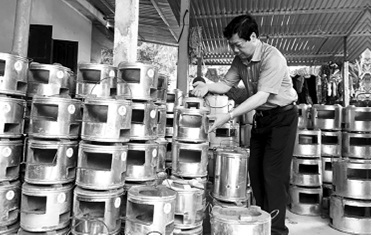

08/09/2017
Currently, in the context of natural resources scarcity, many countries in the world are promoting low carbon product production and consumption. In Việt Nam, the production and consumption of low carbon products contribute to implement priority areas in the National Green Growth Strategy in the period 2011- 2020, vision to 2050.

Environmentally-friendly TK90 advanced cooker used by households in Phú Thọ province
Some projects on production and consumption of low carbon products in Việt Nam
In Việt Nam, the production and consumption of low carbon products have been implemented in some economic sectors such as industry, agriculture, forestry, construction... and through some programs and projects invested from the state budget and international cooperation between Việt Nam and other countries and organizations such as Denmark, Japan, and the Asian Development Bank (ADB).
Currently, the annual emission from agricultural activities is equivalent to 65 million tonnes of CO2, accounting for more than 43% of the total national greenhouse gases. The main emission sources are from rice cultivation, burning of agriculture sub-products and animal husbandry waste. The development of models piloting low carbon agriculture production technologies are being paid greater attention.
For environmental improvement and greenhouse gas emission, towards the low carbon agriculture economy, the Government has collaborated with ADB to implement the Low Carbon Agricultural Support Project (LCASP) with three contents: Promoting biogas in medium- and large-scale livestock farming systems; biogas associated with comprehensive livestock waste management system; capacity building at all levels to create sustainability for the expansion of the model. The Project implements in 6 years (2013 - 2018) in 10 provinces: Hà Tĩnh, Lào Cai, Sơn La, Phú Thọ, Bắc Giang, Nam Định, Bình Định, Tiền Giang, Bến Tre and Sóc Trăng.
In addition, during 2013 - 2017, Việt Nam collaborates with Denmark in implementing the Project on Low Carbon Transition in Energy Efficiency (LCEE), with the objective to convert the low carbon economy through energy efficiency in small and medium enterprises and construction works. By now, the Project has produced six low carbon products: Ecological cooker using sawdust and straw (advanced husk cooker); biomass boiler (converted from coal boiler); continuous husk brick kiln (manual brick kiln); LGP kiln (converted from coal kiln); continuous husk ceramic kiln (converted from traditional craft ceramic kiln); technology improvement, energy efficiency in fisheries. Low carbon products have been researched for improvement to be appropriate with usage demand and economic development of Việt Nam. The LCEE Project is expanding the production and consumption of products in Bắc Ninh, Bình Dương, Cần Thơ, Đà Nẵng, Đồng Tháp, Hà Nội, Hải Phòng, Hồ Chí Minh city, and Quảng Nam.
Development of low carbon in some other sectors such as fishery and construction (low carbon city model, green criteria for design construction works), low carbon industrial zone… are being implemented in some cities/provinces such as Đà Nẵng, Quảng Nam.
In general, the promotion of production and consumption of low carbon products will contribute to green the production and to promote sustainable consumption. However, this has not been expanded as projects are mostly implemented with international support; only some projects are supported by the state budget.
Solutions to promote the production and consumption of low carbon products in Việt Nam
Although the policy system on sustainable production and consumption is relatively complete, solutions are still relatively general and difficult to implement. To promote the production and consumption of low carbon products, it is necessary to have collaboration among sectors and authorities to implement some specific solutions:
Finalising the legal framework: Reviewing, improving and implementing policies on green consumption and sustainable consumption, focusing on low carbon products; promoting programs to promote sustainable consumption in sectors and fields in the economy; implementing behaviour and habits change activities of consumers on low carbon products; studying criteria and developing procedures for low carbon products labelling to be appropriate with international criteria on low carbon products; effectively implementing policies on green procurement in order to enhance the consumption of environmentally-friendly products and to promote enterprises to participate in environmentally-friendly production.
Particularly, it is necessary to develop supporting policies and special incentive mechanisms for enterprises, organizations, and individuals to invest in greenhouse gas mitigation activities; formulate and improve trade policies, export tax, and import tax on low carbon products to be appropriate with international and regional integration, as well as environmental agreements, bilateral and multilateral free trade agreements.
Science - technology development: Promoting 3R development (waste reduction, recycle, reuse); enhancing scientific research and technology development on clean energy, reducing investments on substantial emission projects; encouraging initiatives on low carbon technologies; implementing scientific and technology activities on agriculture, forestry, land use and energy.
Economics: Promulgating mechanisms and policies supporting and motivating enterprises to participate in low carbon products manufacturing industry; organizing exhibitions and conventions and supporting enterprises to introduce products in supermarkets that have shelves allocated for low carbon products; creating investment capitals on innovations, technologies responding to climate change, green projects, green jobs; incentives on tax, fees for low carbon products.
Awareness raising, education, communication: Providing training and disseminating knowledge, policies and legislations on production and consumption of low carbon products for staff, enterprises and labourers; integrating contents on general sustainable production and consumption and particular low carbon products in education programs at all levels. On the other hand, designing environmentally - friendly advertisement and propaganda programs; developing and implementing communication and propaganda programs on eco-labelling for consumers; implementing labelling, awarding in commercial areas; promoting the role of the mass media in propaganda, disseminating the benefits of low carbon products…
At the same time, the enterprise community needs to actively involve and promote strategies, policies, national action plans on sustainable production and consumption, and green product consumption. Consequently, creating motivations to change the manufacturing technologies towards cleaner production; energy efficiency, fuel savings, and renewable energy usage.
Nguyễn Thị Thu Hoài
Vietnam Environment Administration